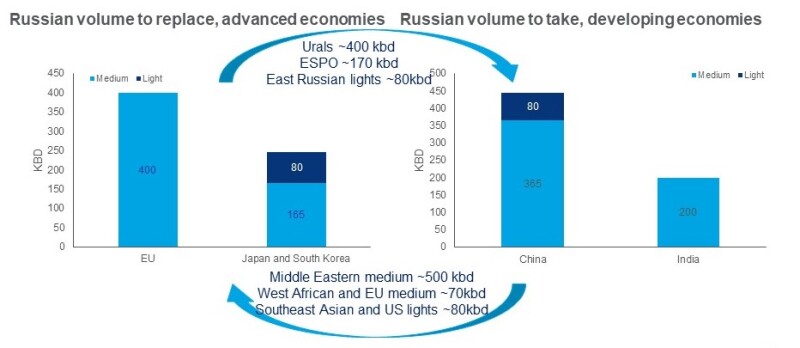Up to 1.2 million B/D of Russian crude oil has been displaced due to US sanctions and European importers that are self-sanctioning. However, over half of that figure—650,000 B/D—may eventually find a new home thanks to “crude swapping.”
This is according to new analysis from international consultancy Wood Mackenzie which said EU nations, along with Japan and South Korea, could exchange Russian supplies from those sourced in the Middle East and bought by China and India.
Refineries in China and India consume a combined 5 million B/D of Middle Eastern grades, indicating that there is more than enough capacity for such swapping.
While China Waits, India Pounces
The research suggests that the current discount applied to Russia’s chief benchmark, Urals crude, which is of similar quality to Middle Eastern oil, also presents an opportunity for China to add to its strategic reserves. But Wood Mackenzie adds that since Russia’s invasion of Ukraine began in late February, China has not made any large purchases of Urals oil.
“This reshuffling is attractive at current Urals discounts but in the near term, refiners face challenges with contractual obligations with Middle Eastern producers,” Alex Sun, a managing consultant with Wood Mackenzie, explained in a statement.
Outside of its long-term contracts, Wood Mackenzie speculates that China might not be so enticed by Russian crude since it takes more than twice as long to receive by tanker than do Middle Eastern shipments. Additionally, international sanctions against Russia have increased the cost of shipping and complicated payment and insurance coverage.

Wood Mackenzie also highlighted that since the war began some Russian crude auctions have been cancelled due to a lack of sufficient bidders.
The upper limit of Chinese and Indian imports of Russian crude might be around 500,000 B/D which would leave around 150,000 B/D to find other Asian buyers. Aside from the final destination of Middle Eastern shipments, Wood Mackenzie said this would also force imports to Asia from African nations and the US to be rerouted elsewhere.
While China may be waiting for its contracts to turn over before making any significant purchasing moves, new data suggests that India is taking greater advantage of the war-induced arbitrage.
Russia has been offering its flagship Ural crude to Indian importers at a discount of up to $35/bbl, according to multiple reports published this week.
An estimate from Reuters pegs Indian imports of Russian oil at around 14 million bbl since the start of the Russia-Ukraine war on 24 February. This is compared with the nearly 16 million bbl that India imported from Russia during all of last year.
$100 Is the Floor
Separate analysis from energy data provider Enverus concluded this week that Europe’s Brent crude benchmark “is now anchored above $100/bbl.”
“With oil prices persistently high since Russia’s late February invasion of Ukraine, we have pared by more than 50% of our expectations for demand growth this year,” Bill Farren-Price, director of Enverus Intelligence Research, said in a statement.
That puts Enverus’ projection for global demand growth in 2022 at around 1.5 million B/D; a figure it said could drop further if global GDP estimates trend down.
Farren-Price noted that European orders of Russian crude have fallen by some 1.5 million B/D since early March due to the “technical challenges and potential reputational damage” associated with buying Russian oil.
For the time being, the EU has not placed any sanctions on importing Russian oil or gas. However, EU officials in Brussels announced this week their intentions to propose a ban on Russian coal and said they may follow on with an additional sanctions package that would include a ban on Russian oil.
Meanwhile, the only nation that has banned Russian oil imports outright is the US which did so nearly a month ago. But the US federal government also gave domestic importers a 45-day window to close out contracts for Russian cargoes which expires on 22 April. With that grace period still in effect, the US imported at least 100,000 B/D of Russian oil during the week of 25 March, according to data from the US Energy Information Administration.


